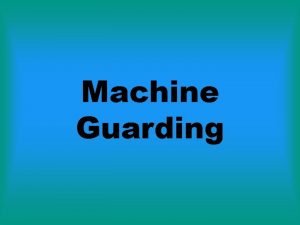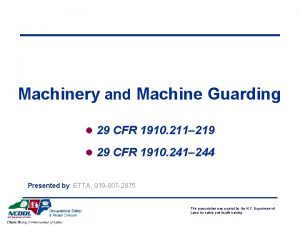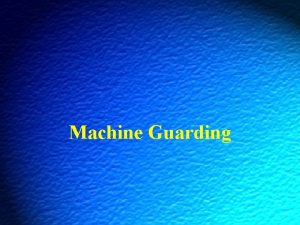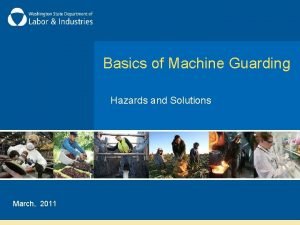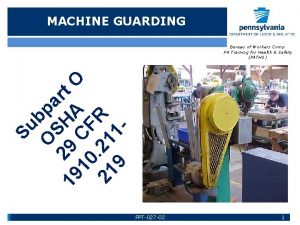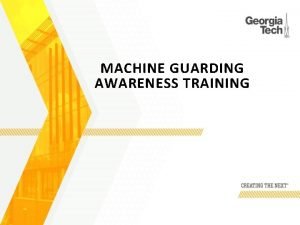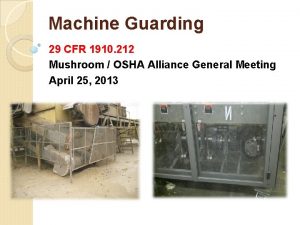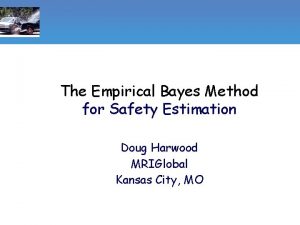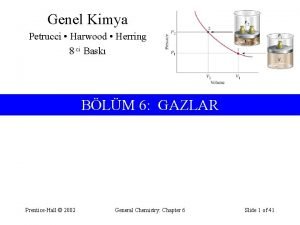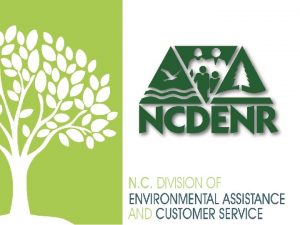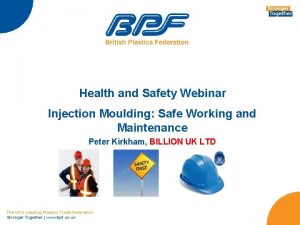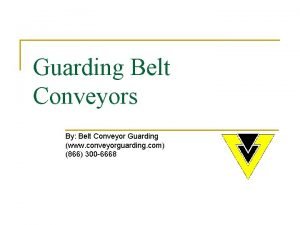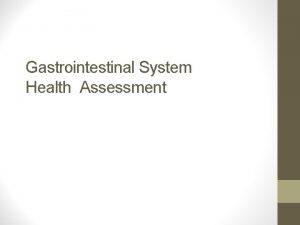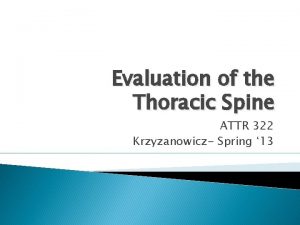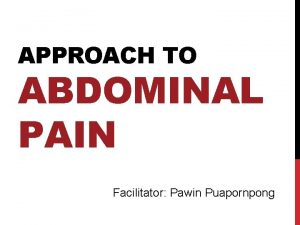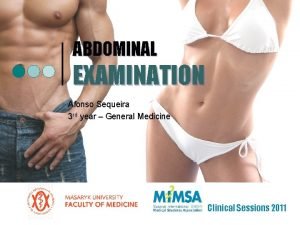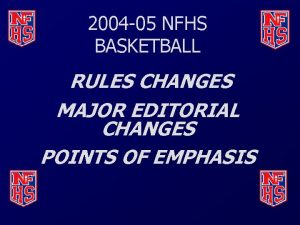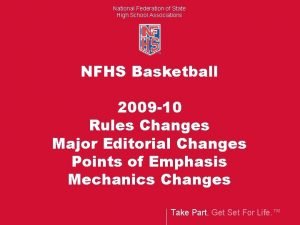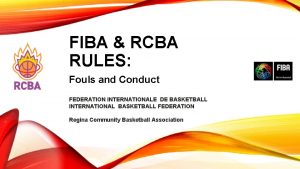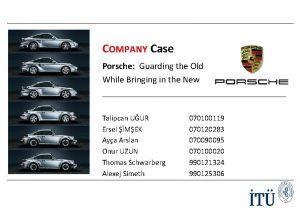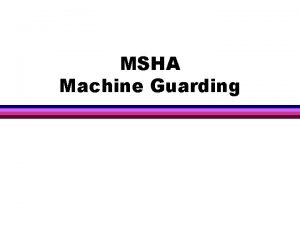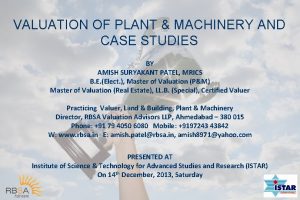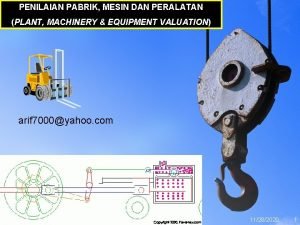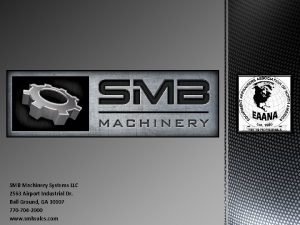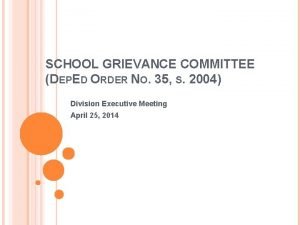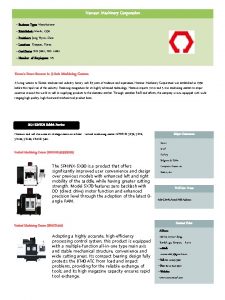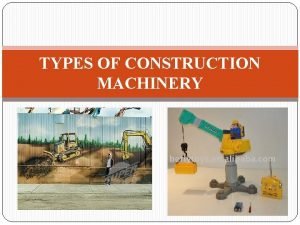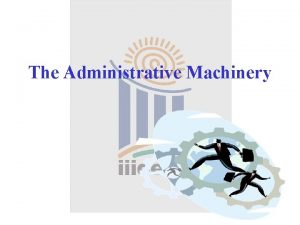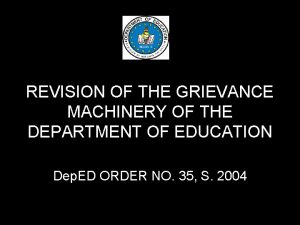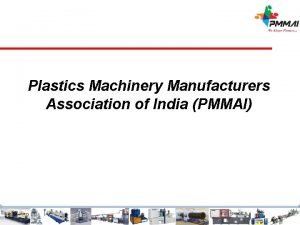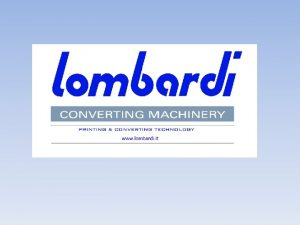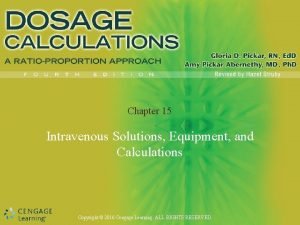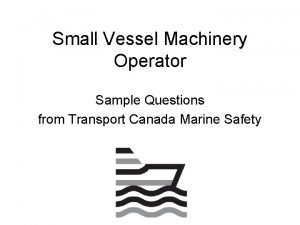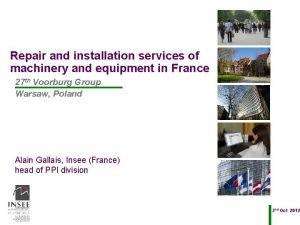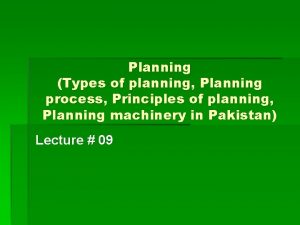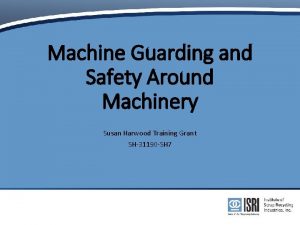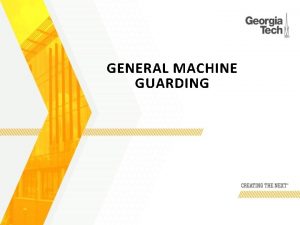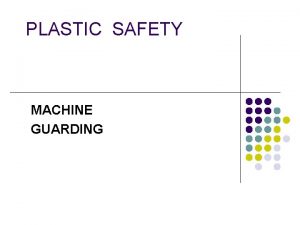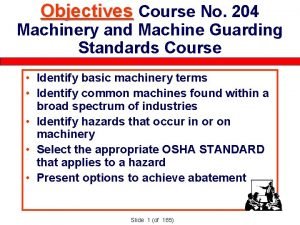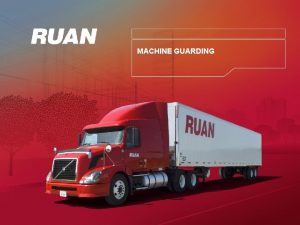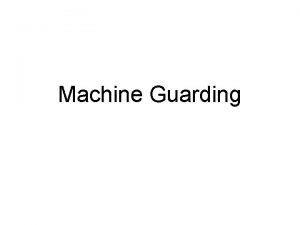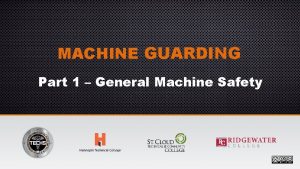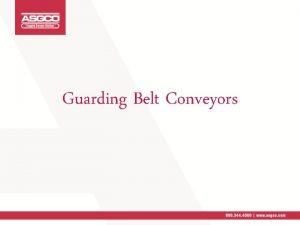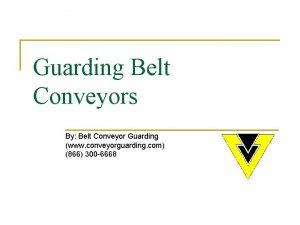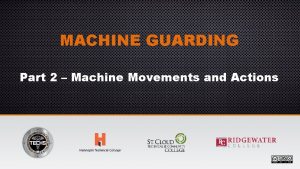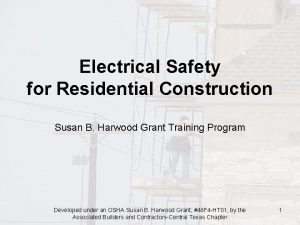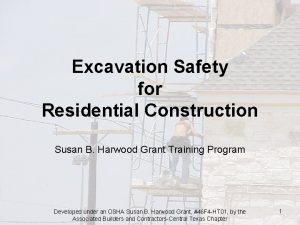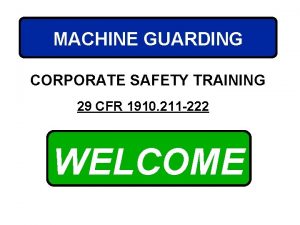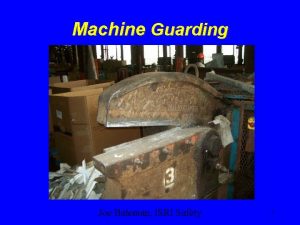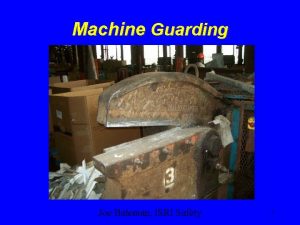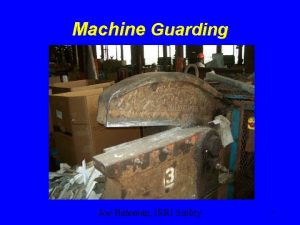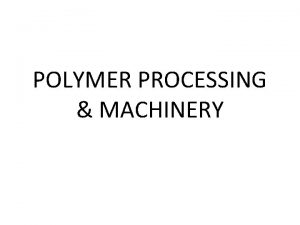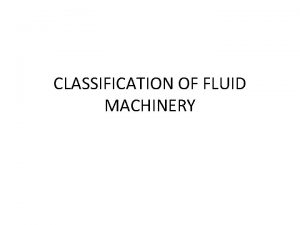Machine Guarding and Safety Around Machinery Susan Harwood






















































- Slides: 54

Machine Guarding and Safety Around Machinery Susan Harwood Training Grant SH-31190 -SH 7

Disclaimers • This material was produced under grant number SH-31190 -SH 7 from the Occupational Safety and Health Administration, U. S. Department of Labor. It does not necessarily reflect the views or policies of the U. S. Department of Labor, nor does mention of trade names, commercial products, or organizations imply endorsement by the U. S. Government. • This training is not intended to replace site or company specific training on the recognition and control of hazards in the workplace. • Photos shown in this presentation may depict situations that are not in compliance with applicable OSHA/safety requirements. • It is the responsibility of the employer and its employees to comply with all pertinent OSHA/safety rules and regulations in the jurisdiction in which they work.

OSHA and your rights In the event of: • • • Firing of laying off Blacklisting Demoting Denying overtime or promotion Disciplining Denial of benefits Failure to hire or rehire Intimidation/harassment Making threats Reassignment affecting prospects for promotion Reducing pay/hours You have protection

OSHA’s Mission With the Occupational Safety and Health Act of 1970, Congress created the Occupational Safety and Health Administration (OSHA) to assure safe and healthful working conditions for working men and women by setting and enforcing standards and by providing training, outreach, education and assistance.

Your Rights The Occupational Safety and Health Act of 1970 gives employees and their representatives the right to file a complaint and request an OSHA inspection of their workplace if they believe there is a serious hazard or their employer is not following OSHA standards. The complaint should be filed as soon as possible after noticing the hazard or lack of compliance because OSHA citations may only be issued for violations that currently exist or existed in the past 6 months. Complaints from workers or their representatives are taken seriously by OSHA will keep your information confidential. How to file a complaint: • By phone • In writing • By fax • In person • Online It is illegal for your employer to fire you for contacting OSHA

OSHA code of federal regulations http: //www. osha. gov

Machinery, Moving Parts, People and Safeguards Machinery and People Safety • People and moving machinery do not mix very well, at some point physical interaction between man and machine will take place! • Maintenance activities • Clearing blockages • Cleaning

Machinery, Moving Parts, People and Safeguards Machinery and People Safety • Why ! • Morally • Safe and free from harm • Legally • Because the dangers from unguarded moving machine parts are real and can cause serious harm or death.

Machinery, Moving Parts, People, and Safeguards Machinery and People Safety • To prevent accidental or inadvertent contact between people and moving machinery, we must have safeguards in place. • Guarding • Controls • Procedures

Principle Machinery Hazards Machinery and People Safety • So what are the Hazards ? • Can you give any examples ? • The hazards are…. .

Principle Machinery Hazards • Five Principle Mechanical Hazards associated with moving parts of machines • Contact or Entanglement • Drawing in • Shearing • Crushing and Impact • Cutting, Friction and Abrasions

Machinery Hazards Moving machinery can cause injuries in many ways: • People can be struck and injured by moving parts of machinery or ejected material. • Parts of the body can also be drawn in or trapped between rollers, belts and pulley drives. • Sharp edges can cause cuts and severing injuries, sharppointed parts can cause stabbing or puncture the skin, and rough surface parts can cause friction or abrasion.

Machinery Hazards • People can be crushed, both between parts moving together or towards a fixed part of the machine, wall or other object, and two parts moving past one another can cause shearing. • Parts of the machine, materials and emissions (such as steam or water) can be hot or cold enough to cause burns or scalds and electricity can cause electrical shock and burns. • Injuries can also occur due to machinery becoming unreliable and developing faults or when machines are used improperly through inexperience or lack of training.

Machinery Hazards CONTACT or ENTANGLEMENT

Machinery Hazards DRAWING IN

Machinery Hazards SHEARING

Machinery Hazards CRUSHING

Machinery Hazards IMPACT

Machinery Hazards CUTTING

Machinery Hazards FRICTION and ABRAISIONS

Machinery Hazards Stabbing and Puncture

Machinery Hazards NUMEROUS HAZARDS

Machinery Safeguards Safeguarding from Machinery Hazards • There are many means of ensuring people do not come into contact with moving parts of machines. • Most notably, GUARDING

Machinery Safeguards Reasons guards are removed • Lubrication • Maintenance • Minor adjustments Take protective measures if guards must be removed to perform maintenance

Machinery Safeguards Safeguarding from Machinery Hazards Just one of the thousands of horrific yet preventable workplace injuries reported each year. Safeguards on machines come in many forms. • Fixed • Interlocked • Distance/Close

Machinery Safeguards Safeguarding from Machinery Hazards Not locked with tool, nut only finger tight Hand reaches across to drawing in hazards

Machinery Safeguards Shearing Hazard Entanglement & Friction Hazards

Machinery Safeguards Safeguarding from Machinery Hazards • Fixed guards should be used wherever possible, properly fastened (nuts and bolts, padlocked) • Which needs a tool to unfasten/remove (spanner, key). So that it is not EASILY defeated. • If you need regular access, and a fixed guard is not possible, interlock guard systems can be installed so that machinery is isolated before access.

Machinery Safeguards Safeguarding from Machinery Hazards • Distance guarding, preventing access to dangerous areas. • Interlocked which immediately stops the item of machinery, once the lock is opened. • Machinery requires resetting once the gates are closed before restart is possible.

Machinery Safeguards • The machinery must be isolated and ‘locked out and tagged out’ before entry to behind guards is permitted. (moving parts). • Isolation means the machine cannot be accidentally or inadvertently switched back on. • Just switching a machine off is not ENOUGH!

Controls Operators working around machinery need to familiarise themselves with the location and operation of the equipment’s emergency stop system(s).

First Day on the Job https: //www. youtube. com /watch? v=c. Ncs. TRQNZLE First Day on the Job was His Last: What Happened to Day Davis Bacardi Bottling Plant – Jacksonville, FL – August 16, 2012 32

Machinery Safeguards • Lock Out Tag Out Program • Is it understandable and easy to follow? • Have you trained the authorized and affected employees? • Have you done your periodic evaluations?

Machinery Safeguards • Beware of unexpected start-up of machinery • Follow your company’s lock-out tag-out policy and procedures. • Always try-out the machinery after you lock it out. • Make sure to recognize and isolate all stored energy possibilities.

Always Lock it Out! • Durable • Standardized • Substantial • Identifiable

Always Lock it Out! • The OSHA standard for The Control of Hazardous Energy (Lockout/Tagout), Title 29 Code of Federal Regulations (CFR) Part 1910. 147, addresses the practices and procedures necessary to disable machinery or equipment, thereby preventing the release of hazardous energy while employees perform servicing and maintenance activities. • In addition, 29 CFR 1910. 333 sets forth requirements to protect employees working on electric circuits and equipment. This section requires workers to use safe work practices, including lockout and tagging procedures.

Lock Out Tag Out Checklist • Annual authorized person training complete • Annual affected person training complete • Disconnects labeled and accessible • Authorized employees have access to locks • All hazards are locked out • Employees maintain key during LOTO • Try (verify) out is done after LOTO is applied • Locks and tags used to identify user • LOTO devices are in good working order • Written procedures accessible to all • Periodic (annual) inspections are getting done

Machinery Safeguards Review • Controlling the hazards; • Procedures, planning, safe working/operating procedures, risk assessments. • Training, competent people, supervision. • Signage, warning, information. • Contractors, method statements, risk assessments, permits to work.

Conveyor Systems • Never wear loose clothing, hoods or other items that could get caught in moving parts. • Never crawl, reach, pry with a tool, or work under a conveyor that YOU have not locked out. • Never walk on or step over a conveyor.

Conveyor Systems

Machine Guarding examples 41

Machine Guarding examples 42

Machine Guarding examples Guarding example at the top of a shredder in-feed. This type of guard is designed to prevent material from flying out of the shredder mill. 43

Machine Guarding examples Mouth of Stationary Shear Follow all manufacturer and OSHA guidelines for safe use and guarding of these tools. 44

Machine Guarding examples Point of operation guard Railing system to prevent falls 45

Machine Guarding examples Table designed to act as distance guards 46

Machine Guarding examples Example of guarding by distance This adjustable has been set-up to prevent the machine operator from getting too close to the point of operation. 47

Machine Guarding examples Better guarding solutions are needed in these areas 48

Machine Guarding examples Bench Grinders Follow all manufacturer and OSHA guidelines for safe use and guarding of these tools. 49

Hand Safety • Know the hand hazards of your working area. • They could be: • • • Electrical Chemical Heat or Cold Handling sharp edged materials Using knives or box cutters Amputation 50

Hand Safety • Determine the Proper PPE and Safe Work Practices • Use proper tools to perform tasks; “notouch” tool • Inspect and replace defective tools • Don’t wear rings, bracelets, or loose fitting clothing • Evaluate how chemicals are handled 51

Hand Safety • Implement a Training Program and Discuss: • Types of hand hazards in the workplace • Types of injuries that can result • Safe work practices to minimize exposure to hazards • Know the proper types and fit of gloves to use 52

Hand Safety & Machine Guarding Preview Video HERE http: //access. mtssafety. com/ISRI/vid. ISRI_Hand. Safety_R 1. htm http: //www. mtssafety. com/ 53

Machinery Safeguards Thank You, Any questions or discussion?
 Machine guard types
Machine guard types 1910 machine guarding
1910 machine guarding Osha 1910 machine guarding
Osha 1910 machine guarding Transverse motion machines
Transverse motion machines Machine guarding ppt
Machine guarding ppt Machine guarding written program
Machine guarding written program 29 cfr 1910
29 cfr 1910 Doug harwood
Doug harwood Harwood imalat işletmesi araştırması
Harwood imalat işletmesi araştırması Crusher hire harwood
Crusher hire harwood Gazlarda yoğunluk formülü
Gazlarda yoğunluk formülü Suburban sonnet gwen harwood
Suburban sonnet gwen harwood Gwen nuttall
Gwen nuttall Joe harwood
Joe harwood Leigh harwood
Leigh harwood كما تدين تدان english
كما تدين تدان english Goes around comes around meaning
Goes around comes around meaning Injection moulding health and safety
Injection moulding health and safety Conveyor guarding
Conveyor guarding Abd quadrants
Abd quadrants Pump handle movement
Pump handle movement Epigastrium
Epigastrium Abdominal guarding
Abdominal guarding Lordcraft pain
Lordcraft pain Tenderness at mcburney's point
Tenderness at mcburney's point Legal guarding position
Legal guarding position Troax sweden
Troax sweden How far is the high school free throw line
How far is the high school free throw line Unsportsmanlike foul fiba
Unsportsmanlike foul fiba Mirror of guarding reflections
Mirror of guarding reflections Tail pulley guard
Tail pulley guard Guarding the gospel
Guarding the gospel Plant and machinery valuation
Plant and machinery valuation Penilaian mesin dan peralatan
Penilaian mesin dan peralatan Classification of plant and machinery
Classification of plant and machinery Alan turing computing machinery and intelligence
Alan turing computing machinery and intelligence Mealy moore
Mealy moore Differentiate between simple machine and compound machine
Differentiate between simple machine and compound machine Smb machinery
Smb machinery District grievance committee
District grievance committee Namsun machinery
Namsun machinery Divine machinery
Divine machinery Types of construction machinery
Types of construction machinery Administrative machinery
Administrative machinery Grievance machinery deped
Grievance machinery deped Plastics machinery manufacturers association of india
Plastics machinery manufacturers association of india Indian pharma machinery manufacturers association
Indian pharma machinery manufacturers association Lombardi converting
Lombardi converting Tomato hb machinery
Tomato hb machinery Drip rates formula
Drip rates formula Textile machinery apush
Textile machinery apush Wage regulation machinery
Wage regulation machinery Small vessel machinery operator program
Small vessel machinery operator program Machinery installation services
Machinery installation services Planning machinery in pakistan
Planning machinery in pakistan
